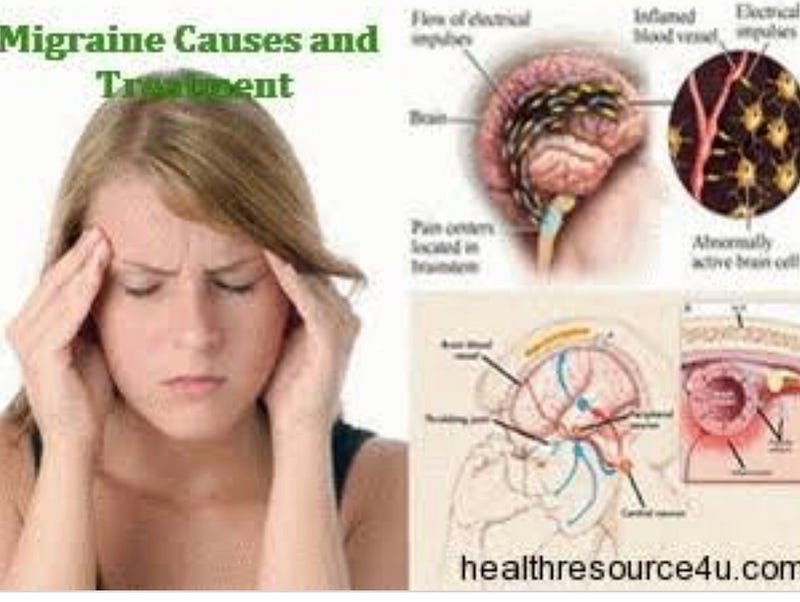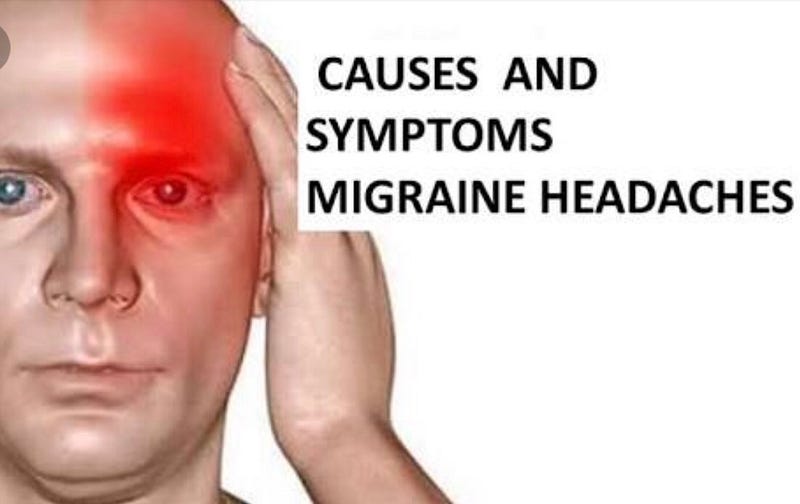MOST COMMON PROBLEM OF HEADACHE (MIGRAINE)
Migraines are pulsating headaches, often on one side of the head. Physical activity may intensify the pain, but symptoms can vary from person to person and from one attack to the next.
Migraine attacks are classified as primary headaches because pain is not caused by another disorder or disease. Migraine attacks are often accompanied by symptoms other than head pain, including nausea, vomiting, sensitivity to light and sound. Migraine symptoms and severity can vary tremendously from person to person.
What are the different types of migraine?
There are several types of migraine recognized by the International Headache Society. The most common migraine types in adults are migraine with aura and migraine without aura. Menstrual migraine, often referred to as hormonal migraine, is the most common type of of migraine without aura. Hemiplegic migraine and basilar migraine are the most common types of migraine with aura. Retinal migraine, which is sometimes referred to as ocular migraine, is another migraine type with migraine symptoms which include changes in vision and blurred vision.
Infants, toddlers, children, and teens often suffer from abdominal migraine, which is characterized by stomach pain, nausea, and vomiting.
There are many other types of headaches which are not categorized as migraines, including but not limited to cluster headaches, tension-type headaches, and sinus headaches.
What are common migraine triggers?
Like symptoms, migraine triggers can also vary from person to person. The most well known migraine triggers relate to food and drink, including MSG, asparatame, alcohol, certain cheeses, chocolate, and citrus fruit. Other common food triggers include certain food dyes, nitrates, sulfites, dairy products, and tyramine.
Some people find that caffeine is a migraine trigger while others can actually find relief from small amounts of caffeine during an attack . Because food triggers can be difficult to identify, a migraine elimination diet can help you find some potential triggers.
Food and drink are not the only factors to consider when identifying migraine triggers. Bright lights or flickering lights can often act as a migraine trigger, including those that may be found in office buildings or old computer monitors. Crying, tension-type headaches, and dehydration are also commonly overlooked migraine triggers.
Some triggers are difficult to avoid, including changes in weather and fluctuations in hormone levels. Others, such as sleep triggers and missed meals, can be well managed by keeping a routine schedule.
What is a migraine aura?
Migraine aura is the second phase of a migraine attack, which is accompanied by distinct symptoms including visual disturbances, loss of vision, dizziness, confusion, aphasia, allodynia, and weakness. Read more about aura symptoms here.
What causes migraines?
The specific cause of migraines is not known, but there may be fluctuations in certain neurotransmitters, chemicals that send messages between brain cells. These changes may predispose some people to develop migraine headaches.
What are the risk factors?
Up to 25% of people experience a migraine headache at some point in their life. Most migraine sufferers are female. It is estimated that after adolescence, the ratio of female to male patients who experience migraines is about 3:1. There seems to be a genetic predisposition to migraine, as there is often a strong family history of migraine in patients with this disorder.
Migraine medications
The treatment of an acute migraine headache may vary from over-the-counter medicines (OTC), like acetaminophen (Tylenol and others), ibuprofen (Advil, Motrin, etc.), naproxen sodium (Aleve) to prescription medications.
Other migraine treatments
Dihydroergotamine (DHE 45) can be administered intravenously or by nasal spray; this medication cannot be used if a triptan has been used within the preceding 24 hours.
Overuse of many of the medications used to treat migraine headache can lead to increased headache frequency, or even daily headaches. This type of headache phenomenon is known as medication overuse headache.
Some patients who experience more than 15 headache days every month might benefit from Botox injections
What remedies and lifestyle changes help manage and decrease the frequency of migraines?
- Maintain a regular schedule for eating and sleeping
- Avoid certain foods that might trigger a migraine
- Keep well hydrated since dehydration has been identified as a migraine trigger for some people
Exercise regularly
Relaxation strategies and meditation also have been recognized as effective strategies to prevent migraines and decrease headache severity.
Exercise and migraine
Some people find that exercises that promote muscle relaxation can help manage the pain of migraines. Examples of types of mind-body exercises that can help encourage relaxation are:
- Meditation
- Progressive muscle relaxation
- Guided imagery
- Yoga
Diet and Migraine
There is no specific diet for people with migraine that helps with symptom relief. However, as mentioned previously, certain foods can be triggers for migraines in susceptible people. These foods include:
- red wines,
- aged cheeses,
- preservatives used in smoked meats (nitrates),
- monosodium glutamate,
- artificial sweeteners,
- chocolate, and
- dairy products.
Alcoholic beverages can also trigger migraine in some people.
6 Migraine Natural Home Remedies for Pain
Most people with this type of headache can manage the pain of mild-to-moderate attacks at home by:
- Using a cold compress on the area of pain
- Resting with pillows comfortably supporting the head or neck
- Resting in a room with little or no sensory stimulation (from light, sound, or odors)
- Withdrawing from stressful surroundings
- Sleeping
- Drinking a moderate amount of caffeine
Hope so here I had cleared your all doubts about migraine problems . let me know how you like this article.
Dr. Shivani Bhardwaj


Comments
Post a Comment